You reuse, renew, recycle. You shop less and mend more. You follow environment-friendly washing habits. But the basics of sustainable design begins with a more radical ambition: smart cutting and draping, and zero waste.
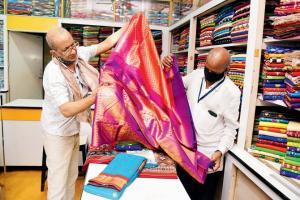
Girgaum resident James Ferreira chooses to shop for handloom and silk fabrics at neighborhood shops to support local businesses. Pics/Shadab Khan
At first appearance, James Ferreira's new, limited-edition collections titled Lady James and James Gent appear to be pieces of polished clothing with a price tag to match. Behind it, however, is a specific method of design, where every part of the hooded kaftan dress with front drape gathers and tassel details, for instance, has been cut and draped with precision from two Bhujodi shawls in a jigsaw pattern to ensure there is zero or less post-production waste. As Indians, Ferreira observes, we are traditionally frugal people, but we lost that innate character in design. "The few [designers] who have managed to break into the Paris Fashion Week calendar, have done it on the strength of textures and textiles that Indian crafts offer. But, where is their own display of talent in developing shapes and silhouettes? It's an empty, empty design world," he rues.
ADVERTISEMENT

Girgaum resident James Ferreira
Khotachiwadi-based Ferreira Ferreira, 64, belongs to the disappearing breed of old-school dressmakers who can magically construct a dress by draping a rectangular piece of cloth directly onto a mannequin, then knot, tuck, layer and sew without cutting the fabric at all. That he continually sources materials from around him, and therefore, supports local markets, whether it's in Bhuleshwar or Girgaum, means he keeps adding to his upcycling story. His men's line features a trio of kurta, pyjama and waistcoat, all created from a single saree sourced from Bhuleshwar market. "Making use of every scrap of fabric is the only secret to surviving the frugal living the pandemic has forced us to adopt."
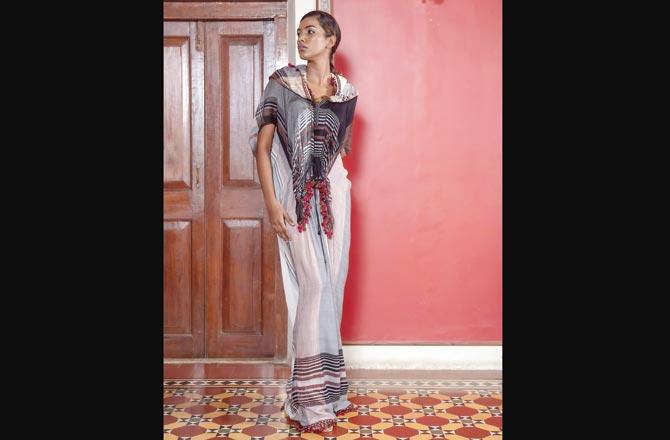
Hooded kaftan dress from the Lady James collection designed using two Bhujodi shawls in a jigsaw pattern to eliminate post-production waste
Delhi-based Arjun Saluja, 46, has designed a range of hybrid lungi-salwar trousers cut on the bias from a single piece of cloth with geometric precision to create clothing patterns that leave not so much as a scrap of fabric on the cutting room floor. "Techniques of draping and pattern cutting are important because they are key to making waste, useful," Saluja says about Sifar, his trans-seasonal, cross-cultural collection.

"Let's Indianise does not extend only to working with craft clusters or embroidery because how then are we developing shapes and silhouettes?" feels Ferreira. Model Henu Dangi wears James Gent. Pic/Akash Tiwari
This drive to make a point through silhouette, and choice of fabric, is something the fashion world also associates with Kolkata designer Kallol Datta, 37. Clothes that fold flat and open with 3D proportions, crafted from kora and muslin cotton, silk chiffon and crepe, often carry silk-screen printing. Just like some designers gravitate towards printmaking or embroidery, Datta was always interested in pattern cutting. And he continues to ask questions through his silhouettes—how do you arrest the natural flow of fabric and make it travel another direction?
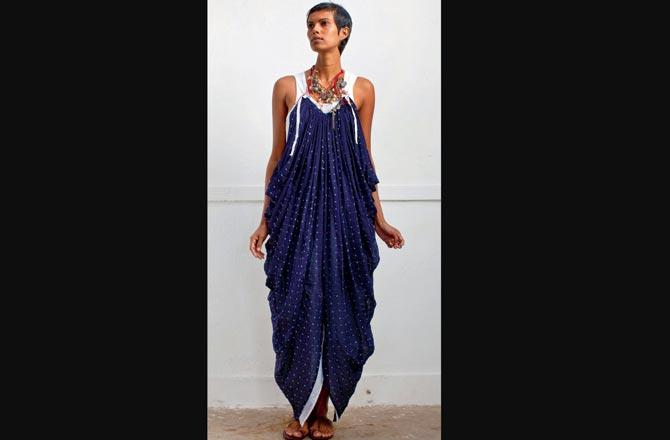
"With the Summer 2010 collection, I revisited traditional Indian shapes and techniques of bias-cut churidar and dhoti drape, quintessential ganjis and fisherman trousers," says Saviojon. Tinu Verghis wears a deconstructed dress with dhoti drape-inspired pleating. Pic/Colston Julian
As the global health and economic crisis endures, 2021 will act as the bridge between the pre-pandemic reality and a potentially protracted recovery period for the global fashion industry, according to the State of Fashion 2021 report published by Business of Fashion (BoF) and McKinsey. "…The pandemic has also prompted a long overdue reckoning for the sector, creating an opportunity for industry re-invention and reset in the coming years. In the post-Coronavirus world, the fashion system will need to be rewired to become more responsible, more sustainable and more human," Imran Amed, founder and CEO of BoF notes in a press release.

Saviojon Fernandes
At home, COVID-19 has highlighted the need for well-grounded Made in India ambitions, making the backstory of Indian fashion far more interesting: an industry in turmoil, the dramatic moving away of karigars and suppliers, digital acceleration and the gradual decline of technical expertise in the face of obvious consumer indifference to fit and quality. Could this Made in India reset possibly skew, ever so slightly, our expectations from clothes and their makers? To look at designers who can truly design—not blind us with razzle-dazzle, not trick us with rhetoric. We are talking designers who approach shape and silhouette as if they were problems to be solved, like the crisis of waste and excess. "It's an ongoing practice including, but not limited to pattern cutting as well as form, shape, emotion and narrative," Saluja points out.
Welcome to the homegrown world of zero-waste design, that Saluja is part of. This is not some anti-establishment plot; it's a way to eliminate millions of tons of post-industrial waste every year. The Ellen MacArthur Foundation study in 2019 estimates that 87 per cent of the total fibre input used for clothing ends up in landfills or is incinerated, with less than 1 per cent of textiles produced for clothing being recycled. But, with traditional fashion media, the need to be topical supersedes the need to carry out long-term conversations about clothing. "Fashion designers and entrepreneurs in the country wouldn't know how to approach a discussion on form today," thinks Datta. "When you are seeking to talk about shape, form, the body, and the silhouettes—it is practically impossible to cut through the noise."
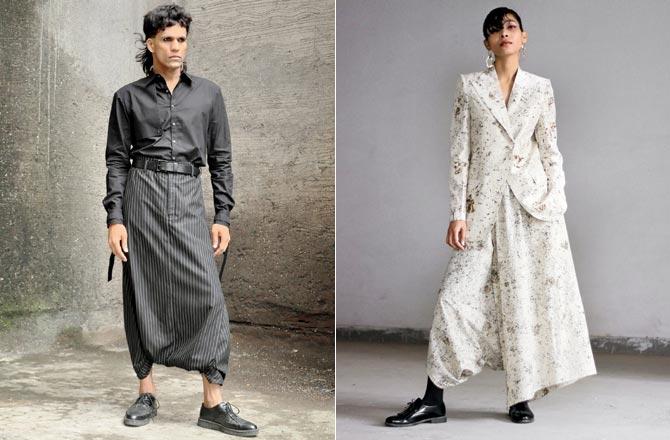
(Left) Arjun Saluja's Azad collection released in September features model Humhu in a trench coat-inspired shirt with reconceptualised Aligarhi trousers; (right) Saluja's Sifar range includes a deconstructed asymmetrical blazer worn with hybrid lungi-salwar trousers cut on the bias from a single piece of cloth with geometric precision to reduce waste
And yet, a small but passionate tribe of designers has spent the last few years quietly investigating traditional silhouettes and techniques, and some of their madcap creative ideas are starting to make common sense. "Good fashion, sustainable fashion is when you marry cut and function," says Saviojon Fernandes, 49. The Goan designer applied to the National Institute of Fashion Technology, Delhi, in 1989, but he was denied admission. "Looking back, I am glad that happened. I might have been another cookie-cutter designer, perhaps making trend-driven clothes, or wedding collections." Instead, interning with the late Wendell Rodricks, Fernandes launched his accessible resort wear label in 1998. His playful yet formal clothes, feminine with a touch of hippie, inspired by Indian silhouettes like dhoti drape and bias-cut churidar, vests and fisherman trousers, and beautifully crafted from locally sourced fabrics, have acquired a cult-like following. He moved to London in 2013 for a summer school programme in pattern cutting from Central Saint Martins. "I've never been impressed by embroidery; we celebrate Christmas once a year, after all!" Fernandes laughs about ostentation. "That's not to say I don't appreciate the decoration, but cut and silhouette informs my designs. The only word that describes our aesthetic is 'anti' since we don't mass-produce, follow trends or sell bridal clothes," he says of his clan.

Arjun Saluja
Saluja says the shape and form should perhaps stand out in fashion debate because it says something about emotion, and social hierarchy. "The dhoti, for example, is India's most inclusive silhouette. A farmer wears the dhoti and works on his fields, a politician wears one to exert power, and what happens in between is called a trend," he says.
This brings us to the ever-relevant question: when did wedding wear and red-carpet opportunities become an absolute holy grail of laudable design? "Hype tops everything else. Who is dressing which celebrity is the sad reality of fashion," feels Fernandes. Within the industry, Datta says, the section that navigates fashion weeks, social media, retail spaces are always told: there has to be more… more of styling elements, more mindless collaborations, more celebrity sightings, more events, more shock, less awe.
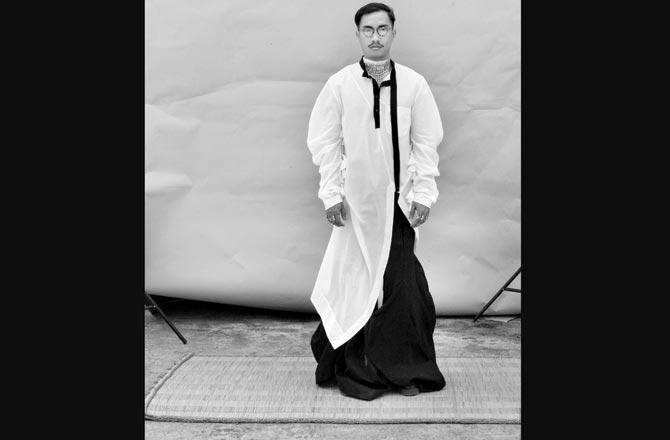
"The current eco-system is not conducive to critical thinking or engagement in design," says Kallol Datta. Pictured here is an askew abaya with tasseled 3D curve sleeves and sharara with 3D folds in kora cotton, cotton mulmul and silk crepe
"Of course, people don't care. No one has the time for this. And I think that's a fantastic lesson about life itself. No one cares. So, I can rant and rave all I want, and it will be amusing to some, but that will be it."

Kallol Datta
87%
Amount of total fibre input used for clothing that ends up in landfills or is incinerated, according to the Ellen MacArthur Foundation study, 2019
Your quick guide to pattern making
Toile /// Essentially a prototype of a garment created to test the design, placement of embellishments, proportions, etc. Made from an inexpensive fabric such as muslin or calico, usually without seam finishes, facings or closures.
3D folds /// Free flowing three-dimensional fabric folds that flow without the aid of pleats, tucks and gathers or ruching techniques.
Balance points /// Marks and notches that help align adjoining pattern pieces when constructing a garment.
Bias /// The diagonal line of the fabric at 45 degrees to the lengthwise and crossway grains. A garment is said to be "cut on the bias" when the warp and weft threads are at 45 degrees to the major seam lines.
Selvedge /// The outside finished edges, parallel to the lengthwise grain of a woven fabric.
Flat pattern making /// Unlike working with toile to drape directly onto the mannequin, this "flat" method is mainly done to the 2D pattern on the pattern making table by referencing existing patterns and measurements while introducing new styles.
Cutting line /// The very edge of the pattern piece, where the fabric is cut. The outermost line is beyond the seamline (or sewing line) and seam allowance.
Grain lines /// Woven fabric consists of yarns that are woven at 90 degrees to each other. The line of the yarn is called a "grain". The grain that runs the length of the yarn is called the warp grain, and the horizontal yarns of the fabric is called the weft (or "crosswise") grain. For example, if you pull woven fabric through the crosswise grain, it will usually have a little move give or stretch than it does across the lengthwise grain. If you pull the fabric at 45 degrees to both of these grains—the bias grain—it will stretch a bit more again. The direction of the grain lines matter because the direction a pattern piece is placed and cut on that grain affects how a garment hangs.
Courtesy: dresspatternmaking.com
Keep scrolling to read more news
Catch up on all the latest Mumbai news, crime news, current affairs, and a complete guide from food to things to do and events across Mumbai. Also download the new mid-day Android and iOS apps to get latest updates.
Mid-Day is now on Telegram. Click here to join our channel (@middayinfomedialtd) and stay updated with the latest news
 Subscribe today by clicking the link and stay updated with the latest news!" Click here!
Subscribe today by clicking the link and stay updated with the latest news!" Click here!






